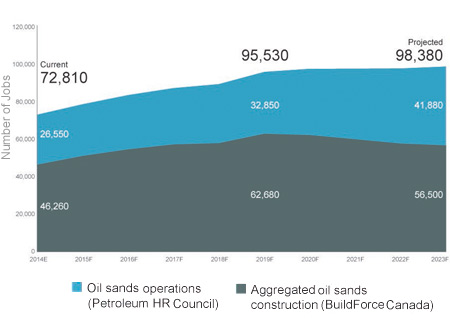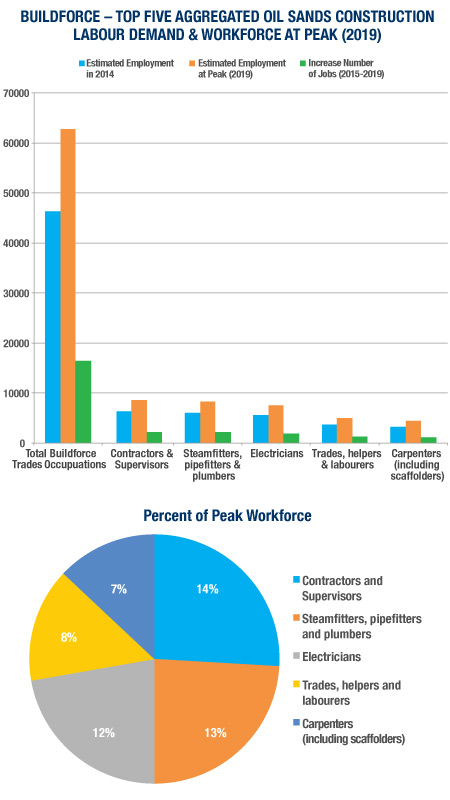Canadian Oil Sands Projects Continue to Vie for Skilled Talent

More than 98,000 oil sands construction, maintenance and operations jobs will be generated over the next decade, according to a new report “the Oil Sands Construction, Maintenance and Operations Labour Demand Outlook to 2023”.
“Accurate labor market information gives us a clear understanding of the workforce issues affecting oil sands development, and helps ensure that $172 billion in wages and salaries continues to generate economic benefits right across this country. This new information helps government and industry make the best possible decisions, and helps Albertans and Canadians make informed choices about their careers,” said Kyle Fawcett, minister of Alberta Jobs, Skills, Training and Labour, in the report.
The Labour Demand Outlook report analyzed data and viewed insights from the construction sector, the oil sands sector and government to highlight the need for the construction and oil and gas industries to work together to ensure the supply of skilled workers supporting future hiring needs.
The report’s projections underscore the significant workforce challenges facing oil sands employers, the Petroleum Human Resources Council noted. Alberta continues to compete for key trades and occupations as other resources, infrastructure and engineering projects across the country get underway.
Specific construction occupations in dire need of manpower are boilermakers, carpenters, electricians and laborers. With more than 98,380 positions vying for skilled talent, the report noted.
Alberta’s oil sands have proven reserves of about 168 billion barrels, and every dollar invested in the resources create about $8 worth of economic activity; with one-third of that economic value generated outside of Alberta, according to the Conference Board of Canada. Moreover, oil sands-related investment is expected to generate $79.4 billion in federal and provincial government revenues between now and 2035.

This year alone, the oil sands sector will produce about 72,810 direct construction and operations jobs, and around 46,260 of those jobs will be within aggregated oil sands construction. These positions include new and sustaining construction, maintenance, and operations; with the remaining 26,550 jobs being direct oil sands operations jobs, supporting in situ, mining and upgrading production, according to the report.
Heavy equipment operators, and power and petroleum engineering occupations face the greatest job increases due to industry activity in oil sands operations with more than 10,000 new jobs projected for in situ operations, a 91 percent increase over 2014 employment levels.
The council noted that employment within oil sands operations, over the next decade, is expected to grow by 15,330 new jobs, for total employment of about 41,880.
Workforce required for on-site oil sands construction, turnaround and ongoing maintenance will be around 48,710 workers in 2014 and will increase to about 56,900 jobs in 2020, a 17 percent increase over 2014 levels. However, construction jobs are expected to dip slightly after 2019 by 6,180 jobs if additional oil sands expansion projects are not announced.

Meeting Future Workforce Demands
As with all oil and gas operations in every country, attrition has the potential to drive a significant number of job openings over the next decade, the report stated. More than 37,500 construction skilled workers and 6,400 oil sand operations in Alberta could be lost due to retirements over the next decade.
“To enhance the supply of skilled workers, oil sands employers will continue recruiting workers from across Canada and abroad, improve productivity through advances in procurement and training and the use of fabrication facilities and modular assembly yards, and by providing career development and succession planning programs that shorten learning curves,” said Carla Campbell-Ott, executive director of the Council.
Collaborative action is required to increase the workforce and address labor requirements, the report noted. The report listed initiatives aimed at enhancing the supply of skilled workers to support the future hiring needs of oil sands construction and operations.
These include:
- Attracting and retaining workforce groups that are under-represented in the construction and oil sands operations sectors.
- Recruiting workers from across Canada and internationally to augment local labor supply.
- Improving productivity through training and through the use of fabrication facilities and modular assembly yards.
- Investing in talent management, including career development and succession planning programs and competence-based programs to assist with shortening the “time to productivity” for new hires.
WHAT DO YOU THINK?
Generated by readers, the comments included herein do not reflect the views and opinions of Rigzone. All comments are subject to editorial review. Off-topic, inappropriate or insulting comments will be removed.
- Africa's Natural Resources: Focus for Both Oil and Gas Sectors
- Apprenticeships Gain Momentum in Upstream Oil, Gas Sector
- Senate Energy, Natural Resources Committee to Vote on Keystone XL Pipeline
- East Africa Must Tackle Challenges to Become an Export Hub
- US Shale Debt Increases as Drillers Push to Maintain Gains
- How Likely Is an All-Out War in the Middle East Involving the USA?
- Rooftop Solar Now 4th Largest Source of Electricity in Australia
- US Confirms Reimposition of Oil Sanctions against Venezuela
- Analyst Says USA Influence on Middle East Seems to be Fading
- EU, Industry Players Ink Charter to Meet Solar Energy Targets
- Russian Ships to Remain Banned from US Ports
- Brazil Court Reinstates Petrobras Chair to Divided Board
- EIB Lends $425.7 Million for Thuringia's Grid Upgrades
- Var Energi Confirms Oil Discovery in Ringhorne
- Seatrium, Shell Strengthen Floating Production Systems Collaboration
- An Already Bad Situation in the Red Sea Just Got Worse
- What's Next for Oil? Analysts Weigh In After Iran's Attack
- USA Regional Banks Dramatically Step Up Loans to Oil and Gas
- EIA Raises WTI Oil Price Forecasts
- How Likely Is an All-Out War in the Middle East Involving the USA?
- Venezuela Authorities Arrest Two Senior Energy Officials
- Namibia Expects FID on Potential Major Oil Discovery by Yearend
- Oil Markets Were Already Positioned for Iran Attack
- Is The Iran Nuclear Deal Revival Project Dead?
- Petrobras Chairman Suspended
- Oil and Gas Executives Predict WTI Oil Price
- An Already Bad Situation in the Red Sea Just Got Worse
- New China Climate Chief Says Fossil Fuels Must Keep a Role
- Oil and Gas Execs Reveal Where They See Henry Hub Price Heading
- Equinor Makes Discovery in North Sea
- Macquarie Strategists Warn of Large Oil Price Correction
- DOI Announces Proposal for Second GOM Offshore Wind Auction
- Standard Chartered Reiterates $94 Brent Call
- Chevron, Hess Confident Embattled Merger Will Close Mid-2024
- Analysts Flag 'Remarkable Feature' of 2024 Oil Price Rally




